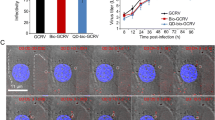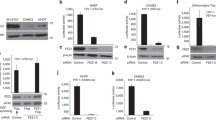Abstract
Microtubule (MT) and dynein motor proteins facilitate intracytoplasmic transport of cellular proteins. Various viruses utilize microtubules and dynein for their movement from the cell periphery to the nucleus. The aim of this study was to investigate the intracellular transport of porcine circovirus type 2 (PCV2) via 8 kDa dynein light chain (DYNLL1, LC8) subunit along the MTs. At 20 μM, vinblastine sulfate inhibited tubulin polymerization resulting in disorganized morphology. In PCV2-infected PK-15 cells, double immunofluorescent labeling showed that the viral particles appeared at the cell periphery and gradually moved to the microtubule organization center (MTOC) at 0−12 hour post inoculation (hpi) while at 20−24 hpi they accumulated in the nucleus. Co-localization between DYNLL1 and PCV2 particles was observed clearly at 8−12 hpi. At 20−24 hpi, most aggregated tubulin had a paracrystalline appearance at the MTOC around the nucleus in vinblastine-treated, PCV2-infected PK-15 cells. Between 12 and 24 hpi, PCV2 particles were still bound to DYNLL1 before they were translocated to the nucleus in both treatments, indicating that vinblastine sulfate had no effect on the protein-protein co-localization. The DYNLL1 binding motif, LRLQT, was found near the C-terminus of PCV2 capsid protein (Cap). Molecular docking analysis confirmed the specific interaction between these residues and the cargo binding site on DYNLL1. Our study clearly demonstrated that dynein, in particular DYNLL1, mediated PCV2 intracellular trafficking. The results could explain, at least in part, the viral transport mechanism by DYNLL1 via MT during PCV2 infection.




Similar content being viewed by others
References
Radtke K, Dohner K, Sodeik B (2006) Viral interactions with the cytoskeleton: a hitchhiker’s guide to the cell. Cell Microbiol 8:387–400
Welte M (2004) Bidirectional transport along microtubules. Curr Biol 14:R525–R537
Dodding MP, Way M (2011) Coupling viruses to dynein and kinesin-1. EMBO J 30:3527–3539
Döhner K, Nagel C-H, Sodeik B (2005) Viral stop-and-go along microtubules: taking a ride with dynein and kinesins. Trends Microbiol 13:320–327
Hall J, Hall A, Pursifull N, Barbar E (2008) Differences in dynamic structure of LC8 monomer, dimer, and dimer-peptide complexes. Biochemistry 47:11940–11952
Rapali P, Szenes Á, Radnai L, Bakos A, Pál G, Nyitray L (2011) DYNLL/LC8: A light chain subunit of the dynein motor complex and beyond. FEBS J 278:2980–2996
Rapali P, Radnai L, Süveges D, Harmat V, Tölgyesi F, Wahlgren WY, Katona G, Nyitray L, Pál G (2011) Directed evolution reveals the binding motif preference of the LC8/DYNLL hub protein and predicts large numbers of novel binders in the human proteome. PLoS One 6:e18818
Alonso C, Miskin J, Hernaez B, Fernandez-Zapatero P, Soto L, Canto C, Rodriguez-Crespo I, Dixon L, Escribano JM (2001) African swine fever virus protein p54 interacts with the microtubular motor complex through direct binding to light-chain dynein. J Virol 75:9819–9827
Hernáez B, Diaz-Gil G, Garcia-Gallo M, Ignacio Quetglas J, Rodriguez-Crespo I, Dixon L, Escribano JM, Alonso C (2004) The African swine fever virus dynein-binding protein p54 induces infected cell apoptosis. FEBS Lett 569:224–228
Poisson N, Real E, Gaudin Y, Vaney MC, King S, Jacob Y, Tordo N, Blondel D (2001) Molecular basis for the interaction between rabies virus phosphoprotein P and the dynein light chain LC8: dissociation of dynein-binding properties and transcriptional functionality of P. J Gen Virol 82:2691–2696
Moseley GW, Roth DM, DeJesus MA, Leyton DL, Filmer RP, Pouton CW, Jans DA (2007) Dynein light chain association sequences can facilitate nuclear protein import. Mol Biol Cell 18:3204–3213
Smith JG, Wiethoff CM, Stewart PL, Nemerow GR (2010) Adenovirus. Curr Top Microbiol Immunol 343:195–224
Segales J, Allan G, Domingo M (2005) Porcine circovirus diseases. Anim Health Res Rev 6:119–142
Fan H, Ye Y, Luo Y, Tong T, Yan G, Liao M (2012) Quantitative proteomics using stable isotope labeling with amino acids in cell culture reveals protein and pathway regulation in porcine circovirus type 2 infected PK-15 cells. J Proteome Res 11:995–1008
Zhang X, Zhou J, Wu Y, Zheng X, Ma G, Wang Z, Jin Y, He J, Yan Y (2009) Differential proteome analysis of host cells infected with porcine circovirus type 2. J Proteome Res 8:5111–5119
Cheng S, Zhang M, Li W, Wang Y, Liu Y, He Q (2012) Proteomic analysis of porcine alveolar macrophages infected with porcine circovirus type 2. J Proteomics 75:3258–3269
Cao J, Lin C, Wang H, Wang L, Zhou N, Jin Y, Liao M, Zhou J (2015) Circovirus transport proceeds via direct interaction of the cytoplasmic dynein IC1 subunit with the viral capsid protein. J Virol 89:2777–2791
Morozov I, Sirinarumitr T, Sorden SD, Halbur PG, Morgan MK, Yoon KJ, Paul PS (1998) Detection of a novel strain of porcine circovirus in pigs with postweaning multisystemic wasting syndrome. J Clin Microbiol 36:2535–2541
Lekcharoensuk P, Morozov I, Paul PS, Thangthumniyom N, Wajjawalku W, Meng XJ (2004) Epitope mapping of the major capsid protein of type 2 porcine circovirus (PCV2) by using chimeric PCV1 and PCV2. J Virol 78:8135–8145
Jantafong T, Boonsoongnern A, Poolperm P, Urairong K, Lekcharoensuk C, Lekcharoensuk P (2011) Genetic characterization of porcine circovirus type 2 in piglets from PMWS-affected and -negative farms in Thailand. Virol J 28:88
Manders EMM, Verbeek FJ, Aten JA (1993) Measurement of colocalization of objects in dual-color confocal images. J Microsc 169:375–382
Costes SV, Daelemans D, Cho EH, Dobbin Z, Pavlakis G, Lockett S (2004) Automatic and quantitative measurement of protein-protein colocalization in live cells. Biophys J 86:3993–4003
Bolte S, Cordelieres P (2006) A guided tour into subcellular colocalization analysis in light microscopy. J Microsc 224:213–232
Carpenter AE, Jones TR, Lamprecht MR, Clarke C, Kang IH, Friman O, Guertin D, Chang JH, Lindquist R, Moffat J, Golland P, Sabatini DM (2006) Cell Profiler: image analysis software for identifying and quantifying cell phenotypes. Genome Biol 7:R100
Notredame C, Higgins DG, Heringa J (2000) T-Coffee: a novel method for fast and accurate multiple sequence alignment. J Mol Biol 302:205–217
Roy A, Kucukural A, Zhang Y (2010) I-TASSER: a unified platform for automated protein structure and function prediction. Nat Proc 5:725–738
Crooks GE, Hon G, Chandonia JM, Brenner SE (2004) WebLogo: a sequence logo generator. Genome Res 14:1188–1190
Pettersen EF, Goddard TD, Huang CC, Couch GS, Greenblatt DM, Meng EC, Ferrin TE (2004) UCSF Chimera—a visualization system for exploratory research and analysis. J Comput Chem 25:1605–1612
Trott O, Olson AJ (2010) AutoDock Vina: improving the speed and accuracy of docking with a new scoring function, efficient optimization, and multithreading. J Comput Chem 31:455–461
Hirosue S, Senn K, Clément N, Nonnenmacher M, Gigout L, Linden RM, Weber T (2007) Effect of inhibition of dynein function and microtubule-altering drugs on AAV2 transduction. Virology 367:10–18
Suikkanen S, Aaltonen T, Nevalainen M, Välilehto O, Lindholm L, Vuento M, Vihinen-Ranta M (2003) Exploitation of microtubule cytoskeleton and dynein during parvoviral traffic toward the nucleus. J Virol 77:10270–10279
Chu JJ, Ng NL (2002) Trafficking mechanism of West Nile (Sarafend) virus structural proteins. J Med Virol 67:127–136
Jacob Y, Badrane H, Ceccaldi PE, Tordo N (2000) Cytoplasmic dynein LC8 interacts with lyssavirus phosphoprotein. J Virol 74:10217–10222
Su Y, Qiao W, Guo T, Tan J, Li Z, Chen Y, Li X, Li Y, Zhou J, Chen Q (2010) Microtubule-dependent retrograde transport of bovine immunodeficiency virus. Cell Microbiol 12:1098–1107
Gaudin R, Alencar BC, De Arhel N, Benaroch P (2013) HIV trafficking in host cells: motors wanted! Trends Cell Biol 23:652–662
Misinzo G, Delputte PL, Lefebvre DJ, Nauwynck HJ (2009) Porcine circovirus 2 infection of epithelial cells is clathrin-, caveolae- and dynamin-independent, actin and Rho-GTPase-mediated, and enhanced by cholesterol depletion. Virus Res 139:1–9
Raux H, Flamand A, Blondel D (2000) Interaction of the rabies virus P protein with the LC8 dynein light chain. J Virol 74:10212–10216
Martinez-Moreno M, Navarro-Lerida I, Roncal F, Albar JP, Alonso C, Gavilanes F, Rodriguez-Crespo I (2003) Recognition of novel viral sequences that associate with the dynein light chain LC8 identified through a pepscan technique. FEBS Lett 544:262–267
Kubota T, Matsuoka M, Chang TH, Bray M, Jones S, Tashiro M, Kato A, Ozato K (2009) Ebolavirus VP35 interacts with the cytoplasmic dynein light chain 8. J Virol 83:6952–6956
Liang J, Jaffrey SR, Guo W, Snyder SH, Clardy J (1999) Structure of the PIN/LC8 dimer with a bound peptide. Nat Struct Biol 6:735–740
Fan J, Zhang Q, Tochio H, Li M, Zhang M (2001) Structural basis of diverse sequence-dependent target recognition by the 8 kDa dynein light chain. J Mol Biol 306:97–108
Lightcap CM, Sun S, Lear JD, Rodeck U, Polenova T, Williams JC (2008) Biochemical and structural characterization of the Pak1–LC8 interaction. J Biol Chem 283:27314–27324
Khayat R, Brunn N, Speir JA, Hardham JM, Ankenbauer RG, Schneemann A, Johnson JE (2011) The 2.3-Angstrom Structure of Porcine Circovirus 2. J Virol 8:7856–7862
Hall J, Karplus PA, Barbar E (2009) Multivalency in the assembly of intrinsically disordered dynein intermediate chain. J Biol Chem 284:33115–33121
Barbar E (2008) New concepts dynein light chain LC8 is a dimerization hub essential in diverse. Biochemistry 47:1–6
Acknowledgements
We thank Prof. Prem S Paul at the University of Nebraska and Dr. Igor Morozov at Kansas State University for providing the plasmid p31/31.
Author information
Authors and Affiliations
Corresponding author
Ethics declarations
Funding
This study was funded by the Thailand Research Fund (Grant Number RSA 55080036).
Conflict of interest
Sirin Theerawatanasirikul declares that she has no conflict of interest. Nantawan Phecharat declares that she has no conflict of interest. Chaiwat Prawettongsopon declares that he has no conflict of interest. Wanpen Chaicumpa declares that she has no conflict of interest. Porntippa Lekcharoensuk declares that she has no conflict of interest.
Ethical approval
This article does not contain any studies with human participants or animals performed by any of the authors.
Rights and permissions
About this article
Cite this article
Theerawatanasirikul, S., Phecharat, N., Prawettongsopon, C. et al. Dynein light chain DYNLL1 subunit facilitates porcine circovirus type 2 intracellular transports along microtubules. Arch Virol 162, 677–686 (2017). https://doi.org/10.1007/s00705-016-3140-0
Received:
Accepted:
Published:
Issue Date:
DOI: https://doi.org/10.1007/s00705-016-3140-0




